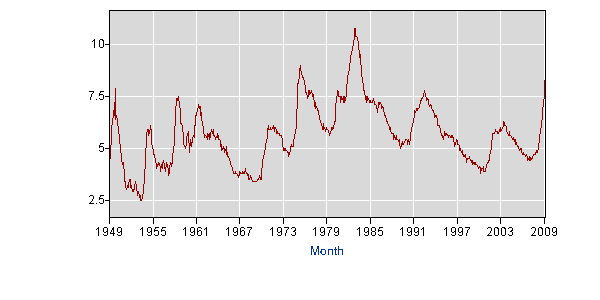April Unemployment Numbers
The Bureau of Labor Statistics have released their preliminary job numbers for April and they aren’t good.
Nonfarm payroll employment continued to decline in April (-539,000), and the unemployment rate rose from 8.5 to 8.9 percent, the Bureau of Labor Statistics of the U.S. Department of Labor reported today. Since the recession began in December 2007, 5.7 million jobs have been lost. In April, job losses were large and widespread across nearly all major private-sector industries. Overall, private-sector employment fell by 611,000.
Unemployment (Household Survey Data)
The number of unemployed persons increased by 563,000 to 13.7 million in April, and the unemployment rate rose to 8.9 percent. Over the past 12 months, the number of unemployed persons has risen by 6.0 million, and the unemployment rate has grown by 3.9 percentage points. (See table A-1.)
Below is unemployment from 1949 to April 2009.
In terms of unemployment this recession is shaping up to be in the top 3 since the Great Depression.
Update: At least one article notes that the pace of job losses has eased, which is true, what remains to be seen is if this easing continues or is just transitory.
Graph via the Bureau of Labor Statistics.





U6 is looking pretty ugly.
I think your graph lacks the most recent 8.9% point. It would be more than half of the way between the 7.5 and 10 scale markers.
What concerns me is not just the job losses (as if that’s not concerning enough) but that the last recovery was followed by phlegmatic job growth other than in government, health care, and home building.
New home construction frequently leads the economy into recovery. Doesn’t look to me as though that will be the case this time. And, frankly, I don’t see government jobs as the powerhouse that will propel the economy into recovery, either.
No, it is in there. You can go to the website and verify for yourself.
Yes, that was also the case with the recovery before that too, but not as pronounced.
All the more reason for a $5 trillion dollar budget next year.